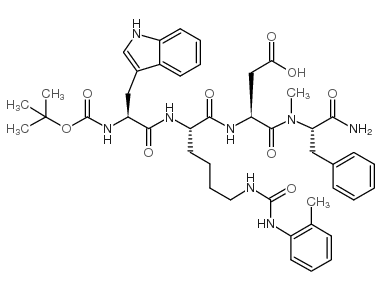130408-77-4
| Name | Boc-Trp-Lys(Tac)-Asp-N(Me)Phe-NH2 |
|---|---|
| Synonyms | Boc-Trp-His-OMe |
| Description | A71623, a CCK-4-based peptide, is a potent and highly selective CCK-A full agonist. The IC50s for A-71623 are 3.7 nM in guinea pig pancreas (CCK-A) and 4500 nM in cerebral cortex (CCK-B) in radioligand binding assays, respectively[1]. |
|---|---|
| Related Catalog | |
| Target |
IC50: 3.7 nM (CCKA receptor in radioligand binding assays)[1] |
| In Vitro | In guinea pig gastric glands, the affinities of A-71623 for the cholecystokinin (CCK)-B/gastrin receptor were 11 μM[1]. |
| In Vivo | A71623 (A-63387; i.c.v., but not i.p., injections) reduces food intakes and suppresses intakes of a liquid diet in both deprived and sated rats[2]. A71623 dampens Purkinje neuron pathology and associates deficits in motor performance in Pcp2-ATXN1[30Q]D776;Cck-/- and Pcp2-AXTN1[82Q] mice[3]. A71623 improves motor performance of Pcp2-ATXN2[127Q] SCA2 mice[3]. Animal Model: Adult male, Sprague-Dawley rats[2] Dosage: 5 μL Administration: Intracerebroventricular (i.c.v) administration, A-71623 was infused using a 28 gauge injection cannula in a volume of 5uL over 60 s Result: Reduced food intakes and suppressed intakes of a liquid diet. Animal Model: ATXN1[30Q]-D776, ATXN1[82Q]-D776, ATXN2[127Q], and WT/FVB/NJ mice [3] Dosage: 0.02 mg/kg/day Administration: Osmotic minipumps containing either A71623 (0.02mg/kg/day) were implanted intraperitoneally (i.p.) Result: Treatment dampened Purkinje neuron pathology in ATXN1[30Q]D776;Cck-/- mice and ATXN1[82Q] mice. Improved motor performance in ATXN2[127Q] mice. |
| References |
| Molecular Formula | C44H56N8O9 |
|---|---|
| Molecular Weight | 840.96 |
| Exact Mass | 840.41700 |
| PSA | 254.15000 |
| LogP | 6.24030 |
| Storage condition | -20°C |
| Precursor 1 | |
|---|---|
| DownStream 0 | |

![N-[(tert-Butoxy)carbonyl]-L-tryptophan structure](https://image.chemsrc.com/caspic/447/13139-14-5.png)